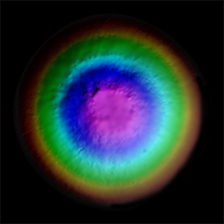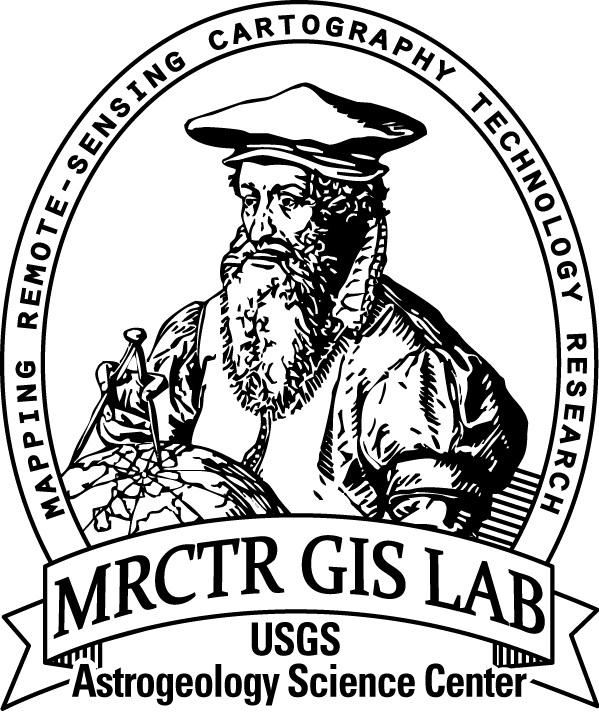Venus Geologic Map of the Artemis Chasma Quadrangle
- Primary Authors
- Roger A. Bannister and Vicki L. Hansen
- Originators
- R. Bannister, V. Hansen
- Publisher
- USGS Astrogeology Science Center
- Publication Date
- 2010-02-10
- Abstract
- Artemis, named for the Greek goddess of the hunt, represents an approximately 2,600 km diameter circular feature on Venus, and it may represent the largest circular structure in our solar system. Artemis, which lies between the rugged highlands of Aphrodite Terra to the north and relatively smooth lowlands to the south, includes an interior topographic high surrounded by the 2,100-km-diameter, 25- to 200-km-wide, 1- to 2-km-deep circular trough, called Artemis Chasma, and an outer rise that grades outward into the surrounding lowland. Although several other chasmata exist in the area and globally, other chasmata have generally linear trends that lack the distinctive circular pattern of Artemis Chasma. The enigmatic nature of Artemis has perplexed researchers since Artemis Chasma was first identified in Pioneer Venus data. Although Venus' surface abounds with circular to quasi-circular features at a variety of scales, including from smallest to largest diameter features: small shield edifices (>1 km), large volcanic edifices (100-1,000 km), impact craters (1-270 km), coronae (60-1,010 km), volcanic rises and crustal plateaus (~1,500-2,500 km), Artemis defies classification into any of these groups. Artemis dwarfs Venus' largest impact crater, Mead (~280 km diameter); Artemis also lacks the basin topography, multiple ring structures, and central peak expected for large impact basins. Topographically, Artemis resembles some Venusian coronae; however Artemis is an order of magnitude larger than the average corona (200 km) and about twice the size of Heng-O Corona (which is 1,010 km in diameter), the largest of Venusian coronae. In map view Artemis' size and shape resemble volcanic rises and crustal plateaus; however, both of these classes of features differ topographically from Artemis. Volcanic rises and crustal plateaus form broad domical regions, and steep-sided regions with flat tops, respectively; furthermore, neither rises nor plateaus include circular troughs. So although it seems clear what Artemis is not, there is little consensus about what Artemis is, much less how Artemis formed. Debate during the past decade has resulted in the proposal of at least four hypotheses for Artemis' formation. The first (herein referred to as H1) is that Artemis Chasma represents a zone of northwest-directed convergence and subduction. The second hypothesis (herein referred to as H2) is that Artemis consists of a composite structure with a part of its interior region marking the exposure of deformed ductile deep-crustal rocks analogous to a terrestrial metamorphic core complex. The third (herein referred to as H3) is that Artemis reflects the surface expression of an ancient (>3.5 Ga) huge bolide impact event on cold strong lithosphere. The fourth hypothesis (herein referred to as H4) is that Artemis marks the surface expression of a deep mantle plume. Each of these hypotheses holds different implications for Venus geodynamics and evolution processes, and for terrestrial planet processes in general. Viability of H1 would provide support that terrestrial-like plate-tectonic processes once occurred on Earth's sister planet. The feasibility of H2 would require high values of crustal extension and therefore imply that significant horizontal displacements occurred on Venus-displacement that may or may not be related to terrestrial-like plate-tectonic processes. The possibility of H3 would suggest that Venus' surface is extremely old, and that Venus has experienced very little dynamic activity for the last 3.5 billion years or more; this would further imply that Venus is essentially tectonically dead, and has been for most of its history. This view contrasts strongly with studies that highlight a rich history of Venus including activity at least as young as 750 million years ago, and quite likely up to the present. If H4 has credibility, then Artemis could provide clues to cooling mechanisms of Earth's sister planet. Each of these hypotheses
Contact and Distribution
- Format
- Geologic Map, Raster Data, Vector Data
- Access Scope
- RPIF
- Series Id
- 3099
- Native Data Set Environment
- Astrogeology Theme
- Cartography, Geology, Geomorphology, Photogeology, Planetary evolution, Stratigraphy
- Online Package Link
- https://astrogeology.usgs.gov/search/map/venus_geologic_map_of_the_artemis_chasma_quadrangle
- External File Size
- 40878777
- Online File Link
- http://astropedia.astrogeology.usgs.gov/download/Venus/Geology/year-2010/Venus-Geologic-Map-of-the-Artemis-Chasma-Quadrangle-V-48.pdf
- Access Instructions
- Pamphlet: i, 22 p.; Figures; Tables; Map Sheet: 53.30 inches x 36.78 inches
- Contact Address
- 2255 N. Gemini Drive
- Contact City
- Flagstaff
- Contact State
- AZ
- Contact Postal Code
- 86001
- Contact Email
- astroweb@usgs.gov
Geospatial Information
- Target
- Venus
- Well Known Text (WKT)
- POLYGON((120 -25, 150 -25, 150 -50, 120 -50, 120 -25))
- Minimum Latitude
- -50
- Maximum Latitude
- -25
- Minimum Longitude
- 120
- Maximum Longitude
- 150
- Object Type
- Grid Cell
- Quad Name
- V-48
- Map Scale (hard-copy)
- 1:5000000
- Horizontal Coordinate System Units
- Degrees



















